#new york dance culture history
Text
#FREEDOWNLOADS #FREEPROMO #RADIOCHART
Roy Thode recorded live at Studio 54 NYC November 5, 1981
This presentation from DJ Roy Thode was recorded live at Studio 54 on Nov.5, 1981. My release of this recording is, almost to the day, 42 years after the night it was recorded. I hope you enjoy this step back in time from Roy's opening records to his 'walking out the door' music at the end of the night as you relive "A Night At Studio 54". Keep On Dancing!!
Скачать:
https://ift.tt/sJrazVA
https://ift.tt/xnuHPRy
#classic disco#house music#retro dance music#new york dance culture history#marsha stern#heartbeat of the dance floor#roy thode#classic dance music#new york nightlife#FreeDownload#FreeTrack#studio54#r&b#hi-nrg#Roy Thode recorded live at Studio 54 NYC November 5#1981 The Heartbeat Of The Dance Floor ®#SoundCloud
3 notes
·
View notes
Text
Exploring Poetry and Dance: Dongpo - Life in Poems

View On WordPress
#chinese#chinese culture#chinese history#dance#dongpo#editorial#Events#life in poems#lincoln center#new york#news#ny#nyc#performance#press#review#shen wei#show#things to do
1 note
·
View note
Link
1 note
·
View note
Photo

“Hip-Hop: Conscious, Unconscious” at NYC’s Fotografiska
In collaboration with Mass Appeal, the photography museum celebrates the worldwide cultural phenomenon On now at NYC’s Fotografiska, Hip-Hop: Conscious, Unconscious comprises photography, video and artifacts from the early days of a Bronx-born subculture that came to influence the world. Co-curated by Sacha Jenkins (filmmaker, writer and Mass Appeal‘s chief creative officer) and Sally Berman (visual director at Hearst, formerly at Mass Appeal and XXL), …
https://coolhunting.com/culture/hip-hop-conscious-unconscious-fotografiska/
#Culture#Art#Bronx#Dance#Documentary Photographers#Exhibitions#FOTOGRAFISKA#Hip-Hop#History#Mass Appeal#Music#New York City#NYC#Photographers#Photography#Rap#Street Photographers#Katie Olsen#COOL HUNTING®
0 notes
Text
Places Where You Can Experience African Lifestyle in New York
Whether it's visiting a significant historical landmark, a famed restaurant, an influential music venue, or a well-known museum, there are numerous opportunities to engage with the contemporary African lifestyle in New York.
#African Lifestyle in New York#Enjoy the African Experience#Harlem in New York City#African Burial Ground National Monument#African-American history#Black Culture#Alvin Ailey American Dance Theater#Jacob Javits Federal Building#Fatherland New York
0 notes
Text
🎨 Ernie Barnes 🎨

Ernie Barnes - The Gospel Truth - 1985

Ernie Barnes - Solid Rock Congregation - 1993
Ernie Barnes
July 15, 1938 – April 27, 2009
A leading 20th century artist well-known for his unique style of movement, Ernie Barnes is the first American professional athlete to become a noted painter. His works are shown, collected and respected internationally. In pop culture Barnes’ artwork appears on music album covers, television and movies, especially his iconic dance hall scene, The Sugar Shack.

Ernie Barnes painting "The Sugar Shack" – used for Marvin Gaye's "I Want You" album artwork – was sold for a whopping $15.3 million dollars.

'The Big Ern' - a 24" x 36" self portrait - He gave this painting to Charlton Heston in 1969.

He was #61 for the San Diego Chargers who were coached by Al Davis back then.
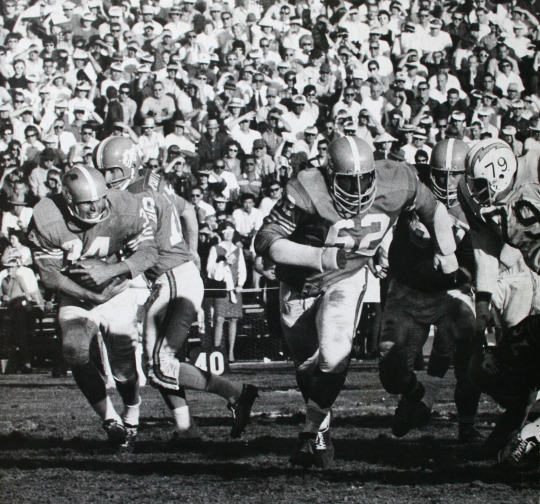
The 6' 3" 250 lb. offensive guard was #62 when he played for the Denver Broncos.
Shortly after his final football game, Barnes went to the 1965 AFL owners meeting in Houston in hopes of becoming the league's official artist. There he was introduced to New York Jets owner Sonny Werblin, who paid for Barnes to bring his paintings to New York City. Later they met at a gallery and unbeknownst to Barnes, three art critics were there to evaluate his paintings. They told Werblin that Barnes was "the most expressive painter of sports since George Bellows."
In what was one of the most unusual posts in the history of the AFL, Werblin retained Barnes as a salaried player, but positioned him in front of the canvas, rather than on the football field.
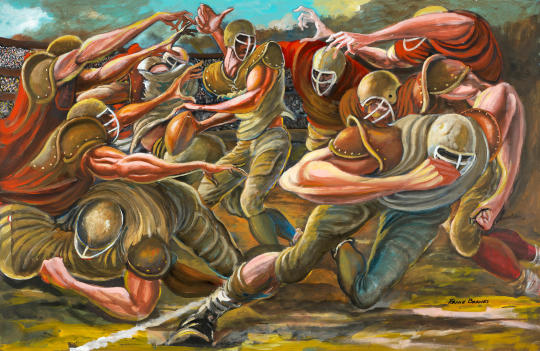
Pocket Passer 26 1/8 x 40 in - 1992

In his studio
Ernest Eugene Barnes Jr.
July 15, 1938 - April 27, 2009 (aged 70)
#art#Ernie Barnes#Gospel Truth#Solid Rock Congregation#paintings#afl#football#album cover art#afl artist#chargers#jets#broncos#al davis#charlton heston#artist#Ernest Barnes#cliff clavin
561 notes
·
View notes
Text
Praise houses
Praise houses were small, wooden structures used for worship by enslaved people in the American Southeast. They were also known as prayer houses. Praise houses were typically built within plantation complexes. They were often an elder enslaved individual's cabin.

Praise houses were a part of the early history of the Black church. There is evidence of Christian practice and praise houses from before the first organized Black denominations.
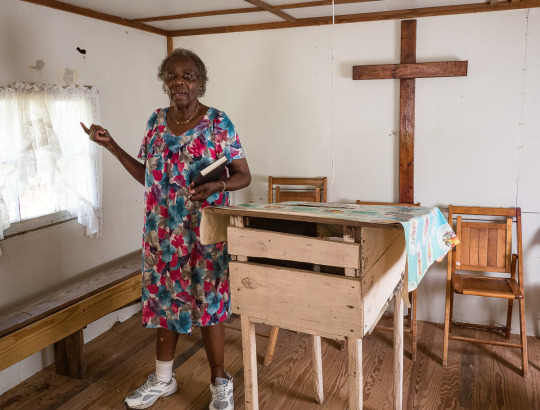
In praise houses, enslaved African Americans held religious services, shared news, and settled disputes. Services were typified by singing, prayer, and the "shout," which was a song accompanied by vigorous hand-clapping and dancing. As an act of resistance, congregants would gather in circle to stomp or shout upon the wooden floors, performing what was known as the Ring Shout.

These gatherings were not only religious but also a form of resistance and a means of preserving cultural and spiritual traditions in the face of oppression.
youtube
"The true shouť takes place on Sundays or on 'praise'-nights through the week, and either in the praise-house or some cabin in which a regular religious meeting has been held. Very likely more than half the population of the plantation is gathered together. Let it be the evening, and a light-wood fire burns red before the door to the house and on the hearth.… The benches are pushed back to the wall when the formal meeting is over, and old and young, men and women, sprucely-dressed young men, grotesquely half-clad field hands—the women generally with gay handkerchiefs twisted about their heads and with short skirts, boys with tattered shirts and men's trousers, young girls barefooted—all stand up in the middle of the floor, and when the 'sperichil' is struck up, begin first walking and by-and-by shuffling round, one after the other, in a ring. The foot is hardly taken from the floor, and the progression is mainly due to a jerking, hitching motion, which agitates the entire shouter, and soon brings out streams of perspiration. Sometimes they dance silently, sometimes as they shuffle they sing the chorus of the spiritual, and sometimes the song itself is also sung by the dancers. But more frequently a band, composed of some of the best singers and of tired shouters, stand at the side of the room to 'base' the others, singing the body of the song and clapping their hands together or on the knees. Song and dance are alike extremely energetic, and often, when the shout lasts into the middle of the night, the monotonous thud, thud of the feet prevents sleep within half a mile of the praise-house."
— New York Nation, May 30 , 1867
54 notes
·
View notes
Text

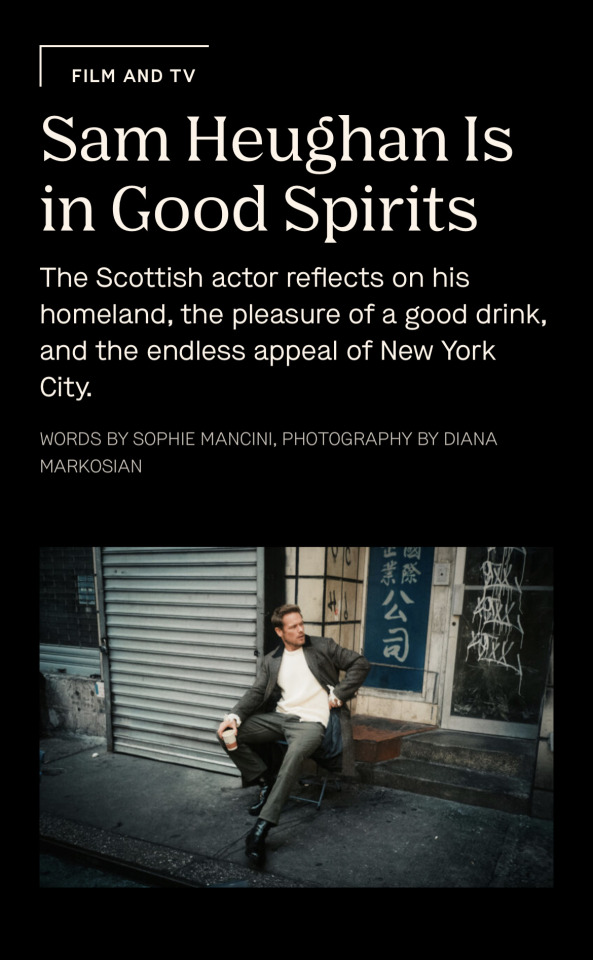
I HAVE AN obsession with the color green. It’s a color of opposites. Green is life, growth, and health. It’s also sickness, greed, and envy. It’s good and bad at once. And it’s everywhere this afternoon as I sit down with actor, producer, author, and entrepreneur Sam Heughan — most recognized for his starring role in the Scotland-based time travel drama “Outlander.” His shirt bears a green tartan pattern, somewhere between jade and emerald. To my right, the glass bottle of his new gin is a transparent seafoam. Above my head is the leafy expanse of a tree, planted in the courtyard of New York’s Crosby Street Hotel. The gin we sip tastes green: grassy and alpine, fresh as menthol and bright as a sour apple. Most vividly is the green in my mind’s eye: the wet, rich, misty green of Scotland, a place Heughan speaks of with rapture.
Missing home is what drove Heughan to launch his spirits brand Sassenach, after the Scottish Gaelic word for an English person, or rather, an “outsider.” “When I was in London away from home, a jobbing actor, missing Scotland, I remember my first time trying a single malt whisky and I had such an emotional reaction,” he recalls from across the table, his bright blue eyes wide. “It reminded me of Scotland.”
I remark on the gin’s legs, thick and viscous, streaking the sides of my glass. Heughan nods, “I increased the strength. It just gives it a bit more weight. I love a bit of weight on my tongue.” Toasted oats give a creamy feel to the cornucopia of flavors present in the liquid: pine resin, heather, blackberry leaf, blaeberry — and, again, that sour green apple. “There’s no citrus in Scotland. That’s why I chose apples,” Heughan explains. “I remember as a kid, picking them and throwing them at people, eating them, then being really ill because they’re so sour.”

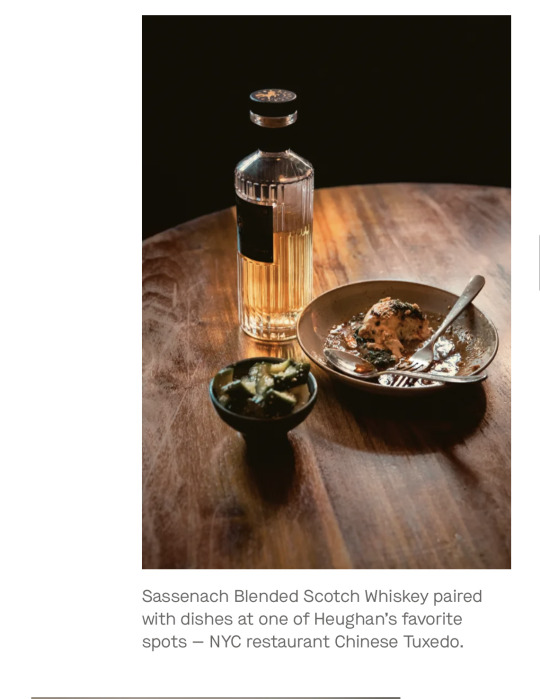

Heughan’s family — his mother, brother, and uncle — still live in Scotland. His uncle used to have a ceilidh band. “[Ceilidh is] a traditional Scottish dance,” he explains. “It’s madness. Everyone’s drinking whisky and the dancers get faster and faster and there are lots of spinning people around.” Heughan listens to a lot of Scottish music. He later sends me a song called “Blackbird” by Martyn Bennett, known for mixing dance tracks with traditional Celtic music. I tear up at its aching slants. “It makes me homesick for a home that’s not mine,” I message him. “That’s Scotland,” he writes back. “It does that to people.”
Sam Heughan Is in Good Spirits Image Float
Heughan was raised by a single mother in the south of Scotland — the rural stretches of Dumfries and Galloway. “Spent a lot of time on my own pretending I was a knight or Robert the Bruce.” The land’s botanicals now flavor his gin. Courtesy of Sam Heughan.
“It’s one foot in the present, one in the past,” muses Heughan about his country, adding a splash of tonic to my gin, whose flavor now reveals a pleasant salinity. “The castles. So many great battles. You
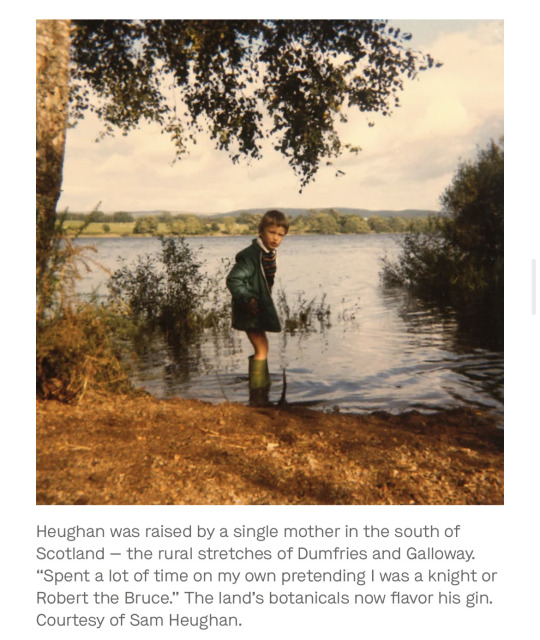
can feel the history. I think that’s what makes it so magical.” This history is inextricably linked to ritual, observed in Scotland to this day. Take Beltane, a pagan ritual beginning serendipitously on Heughan’s birthday, April 30. “You’re supposed to stay up all night and wash your face in the fresh dew when the sun rises, then go to bed and dream of your future spouse,” he describes. “It’s all about rebirth and nature.”
We talk about other parts of the world that have shaped him, as I remark on his fusion accent: a bit Scottish for sure, but mixed with something else, sort of American and British, too. America’s opportunity and diversity captivate Heughan. He came here for the first time at 18, hostel hopping in San Francisco. “I remember looking at the Golden Gate Bridge for hours, playing my cassette of ‘(Sittin’ On) the Dock of the Bay’ by Otis Redding over and over. I was living on $5 burritos — one a day. It’s all I could afford.” He speaks of Hawaii with reverence — the local culture’s connection to wildlife and the sea. He spent time with a fisherman and his family there who taught him the Indigenous way to fish: “Gut it straight away. Take out the heart, say a prayer, and throw it back into the ocean immediately to allow the soul of the fish to live on.” New Zealand also moves him. He was there recently and learned about tā moku, the art of Māori tattooing. “You sit with an artist and tell him your story. He chooses where it goes on your body and makes it there and then. He stuck [the initial sketch] on my left forearm here, and it was all about my mom and my brother and the absence of my father.” He wants to return to New Zealand and get the tattoo next time.
My gin has opened up even more, spreading out into softer, aromatic florals as Heughan uncorks a bottle of his whisky. “People have called you a global heartthrob.” I begin, “Is that a role you’re —”
“Who has?” His eyes grow bigger in feigned shock. (Fun fact: the Sam Heughan fanbase even has their own name — “Heughligans.”)
“Someone I talked to in the subway.”
“Right, right,” he nods gravely, pouring new glasses.
“Do you,” I continue, taking a sip, “feel comfortable in that role?” The whisky tastes like a spicy Werther’s caramel.
“My character is what some people aspire to, and I understand why. He’s this incredible human being who’s just so in love with his wife and does the most romantic things. Selfless. People then think you might be that person. I’m certainly not. But it’s something to aspire to.”
“Are you comfortable,” I press, “being an object of desire?” Heughan shares that in earlier years, he was treated in a way that would no longer be tolerated. “I’d be asked, ‘What’s under your kilt?’ or ‘How do you get your abs?’ I wish I did have abs! We were just in a different industry. I don’t have resentment or a grudge. But I would like to be seen for the work that I do, rather than my looks.”

While he’s still based in Scotland, Heughan also has a house in LA, a city he’s not exactly sold on. He toys with the idea of New York as his next home base. He loves it here. “The cocktail bars. Cycling along the West Side. SoHo. The river. Getting a ferry. I’m so into ferries! I’ll go to Staten Island, then come back again. We got a helicopter the other day back from the Hamptons — I don’t like helicopters. They’re not meant to fly. However, seeing the Statue of Liberty from there, it’s so good. New York could be my city.”
I show Heughan around some local spots that evening. We sit at the bar of Superbueno for mezcal drinks and tacos. The music gets louder and so do the crowds. Mouth full of al pastor, I semi-shout a question in Heughan’s direction, asking if he ever gets overstimulated. “No, not really,” he replies simply, between chewing. At 6 feet, 3 inches, Heughan towers over seemingly everyone. Maybe it’s calmer up there. There’s an overall good-natured quality to him; it’s soothing to be around.
We head to another bar, Mr. Fongs. The air is thick with the smell of trash and rats dart to and fro. A subway thunders overhead as we walk below a bridge in Chinatown. “This is awesome,” Heughan murmurs. We order the bar’s specialty: salty plum old-fashioneds. “I want a place where the second I walk out my door, I’m right in the center of all of it,” he says decidedly, whistling a little at the (notoriously strong) drink. “Right in the middle.”
Heughan is noticeably unadorned. I suggest some rings and an ear piercing for his New York era. A candle light flickers against his cheek, evoking another world — someplace old and rural and rugged. At this moment, I see his character, a fantasy projection of the leading man. But really, we’re just in Chinatown, weighing the pros and cons of earrings on men. “Sadly I don’t think I’m quite cool enough,” he sighs, “to pull that off.” ▪️
Our Contributors
Sophie Mancini Writer
Sophie Mancini is an editor at Departures. Born and raised in New York City, she holds a degree in creative writing from Johns Hopkins University and has a background as a writer in brand and editorial.
Diana Markosian Photographer
Diana Markosian (born in Moscow, 1989) is a Russian-American photographer of Armenian descent. Her work explores memory and place through a layered, interdisciplinary process that uses photography and video. Her photographs have been published in National Geographic, the New Yorker, and the New York Times.
Robert Ormerod Photographer
Robert Ormerod is a photographer interested in telling stories. He is based in Scotland, working across the U.K. for titles such as National Geographic, The Guardian Saturday magazine, The New York Times, T Magazine, The Wall Street Journal, and Bloomberg Businessweek.
Tom Craig Photographer
Tom Craig is a photographer and director whose work has been featured in Vogue, i-D, and Vanity Fair. His work is driven by a desire to tell stories and the urge to travel. His work often blurs the line between fashion photography and straightforward reportage.
**Full article from @departures www.departures.com
57 notes
·
View notes
Text
Theory: Valentino was the famous 1920s actor Rudolph Valentino, the "Latin Lover".

Who was Rudolph Valentino?
Rodolfo Pietro Filiberto Raffaello Guglielmi di Valentina d'Antonguella (May 6, 1895 – August 23, 1926), known professionally as Rudolph Valentino and nicknamed the "Latin Lover", was an Italian actor based in the United States who starred in several well-known silent films from 1921 to 1926, including The Four Horsemen of the Apocalypse, The Sheik, Blood and Sand, The Eagle, and The Son of the Sheik.
Valentino was a sex symbol of the 1920s, known in Hollywood as the "Latin Lover" (a title invented for him by Hollywood moguls), the "Great Lover", or simply "Valentino". His early death at the age of 31 caused mass hysteria among his fans, further cementing his place in early cinematic history as a cultural film icon.
Valentino was born in Castellaneta, Apulia, Italy…unable to secure employment in Italy, he departed for the United States in 1913. He was processed at Ellis Island at age 18 on December 23, 1913. Valentino never applied for American citizenship, and retained his Italian citizenship.
Arriving in New York City, he supported himself with odd jobs such as busing tables in restaurants and gardening. Around 1914, restaurateur Joe Pani who owned Castles-by-the-Sea, the Colony, and the Woodmansten Inn was the first to hire Rudolph to dance the tango with Joan Sawyer for $50 per week.
Eventually, he found work as a taxi dancer at Maxim's Restaurant-Cabaret. Among the other dancers at Maxim's were several displaced members of European nobility, for whom a premium demand existed…Valentino left town [in 1917], and joined a traveling musical that led him to the West Coast.
[…] With his dancing success, Valentino found a room of his own on Sunset Boulevard, and began actively seeking screen roles. His first part was as an extra in the film Alimony, moving on to small parts in several films. Despite his best efforts, he was typically cast as a "heavy" (villain) or gangster. At the time, the archetypal major male star was Wallace Reid, with a fair complexion, light eyes, and an All-American look, with Valentino the opposite; he eventually supplanted Sessue Hayakawa as Hollywood's most popular "exotic" male lead.
[…] With the Douglas Fairbanks type being the supposed epitome of manhood, Valentino was sometimes portrayed as a threat to the "All American" man. One man, asked in a street interview in 1922 what he thought of Valentino, replied, "Many other men [say they] desire to be another Douglas Fairbanks. But Valentino? I wonder…"
Women in the same interview found Valentino, quote, "Triumphantly seductive. He puts the love-making of the average husband or sweetheart into discard as tame, flat, and unimpassioned."
Some journalists were still calling [Valentino's] "masculinity" into question, going on at length about his pomaded hair, his dandyish clothing, his treatment of women, his views on women, and whether he was "effeminate" or not. Valentino hated these stories, and was known to carry clippings of the newspaper articles around with him and criticize them.
In July 1926, the Chicago Tribune reported that a vending machine dispensing pink talcum powder (face powder) had appeared in an upscale hotel's men's washroom. An editorial that followed used the story to protest the supposed feminization of American men, and blamed the talcum powder on Valentino and his films. The piece infuriated Valentino, and he challenged the writer to his choice of a boxing or wrestling match, since dueling was illegal. Neither challenge was answered.
Shortly afterward, Valentino met with journalist H. L. Mencken for advice on how best to deal with the incident. Mencken advised Valentino to "let the dreadful farce roll along to exhaustion" (i.e. "do nothing"), but Valentino insisted the editorial was "infamous", [and must be answered for in a one-on-one fight].
After Valentino challenged the Tribune's anonymous writer to a boxing match, the New York Evening Journal boxing writer, Frank O'Neill, volunteered to fight in his place. Valentino won the bout, which took place on the roof of New York's Ambassador Hotel.
Heavyweight champion Jack Dempsey, who trained Valentino and other Hollywood notables of the era in boxing, said of him: "He was the most virile and masculine of men. The women were like flies to a honeypot. He could never shake them off, anywhere he went. What a lovely, lucky guy."
Mencken found Valentino to be likable and gentlemanly, and wrote sympathetically of him in an article published in The Baltimore Sun a week after Valentino's death:
"It was not that trifling Chicago episode that was riding him; it was the whole grotesque futility of his life. Had he achieved, out of nothing, a vast and dizzy success? Then that success was hollow as well as vast—a colossal and preposterous nothing. Was he acclaimed by yelling multitudes? Then every time the multitudes yelled, he felt himself blushing inside…the thing, at the start, must have only bewildered him, but in those last days, unless I am a worse psychologist than even the professors of psychology, it was revolting him. Worse, it was making him afraid…here was a young man who was living daily the dream of millions of other men. Here was one who was catnip to women. Here was one who had wealth and fame, and here was one who was very unhappy [in spite of that wealth and fame]."
[…] Valentino was also the "sex symbol" of his time in the 1920s. The sheet music cover for "Rodolph Valentino Blues" written in 1922, to quote the lyrics, "Oh Mister Rodolph Valentino / I know I've got the Valentino blues / And when you come up on the screen / Oh! You're so romantic, I go frantic at the views!
[…] [Prior to his death], Valentino was fascinated with every part of movie-making. During production on a Mae Murray film, he spent time studying the director's plans. He craved authenticity and wished to shoot on location, finally forming his own production company, Rudolph Valentino Productions, in 1925. Valentino, George Ullman, and Beatrice Ullman were the incorporators.
[…] Valentino once told gossip columnist Louella Parsons that: "The women I love don't love me. The others don't matter." He claims that despite his success as a sex symbol, in his personal love life, he never achieved happiness.
[…] In 1919—just before the rise of his career—Valentino impulsively married actress Jean Acker, who was also [romantically] involved with actresses Grace Darmond and Alla Nazimova.
Acker became involved with Valentino in part to remove herself from the lesbian love triangle, quickly regretted the marriage, and locked Valentino out of their room on their wedding night. The couple separated soon after, and the marriage was never consummated [on account of Acker being a lesbian].
The couple remained legally married until 1921, when Acker sued Valentino for divorce, citing desertion. The divorce was granted, with Acker receiving alimony. She and Valentino eventually renewed their friendship, and remained friends until his death.
[His second marriage to actress Winifred Shaughnessy, known by her stage name, Natacha Rambova—an American silent film costume and set designer, art director, and protégée of Alla Nazimova, his ex-wife's lesbian lover—ended far more poorly.
The two married in 1922, remarried in 1923, and divorced in 1925. Towards the end of their marriage, Rambova was banned from his sets by contract. The end of the marriage was bitter, with Valentino bequeathing Rambova one dollar in his will.]
[…] From the time he died in 1926 until the 1960s, Valentino's sexuality was not generally questioned in print. At least four books, including the notoriously libelous Hollywood Babylon, suggested that [Valentino] may have been gay, despite his marriage to Rambova. For some, the marriages to Acker and Rambova, as well as the relationship with Pola Negri, added to the suspicion that Valentino was gay, and that these were "lavender marriages".
Some claim that Valentino had a relationship with Ramón Novarro, despite Novarro stating they barely knew each other. Hollywood Babylon recounts a story that Valentino had given Novarro an art deco dildo as a gift, which was found stuffed in his throat at the time of his murder. It is believed that no such gift existed.
There were also claims that he may have had relationships with both roommates Paul Ivano and Douglas Gerrad, as well as Norman Kerry, and openly gay French theatre director and poet Jacques Hébertot. However, Ivano maintained that it was untrue, and both he and Valentino were heterosexual. Biographers Emily Leider and Allan Ellenberger generally agree that [Valentino] was most likely straight, [though others have disputed this].
There was further supposed evidence that Valentino was gay; documents in the estate of the late author Samuel Steward indicated that Valentino and Steward were sexual partners. However, evidence found in Steward's claim was subsequently found to be false, as Valentino was in New York on the date Steward claimed a sexual encounter occurred in Ohio.
[Valentino died on 23 August 1926, at the age of 31, due to complications from perforated ulcer surgery, resulting in sepsis (bacterial poisoning), a collapsed lung, and other fatal conditions.]
#hazbin hotel#hazbin hotel theory#hazbin hotel headcanon#hazbin hotel fan thory#valentino#hazbin valentino#hazbin hotel valentino#the vees#the vs
27 notes
·
View notes
Text

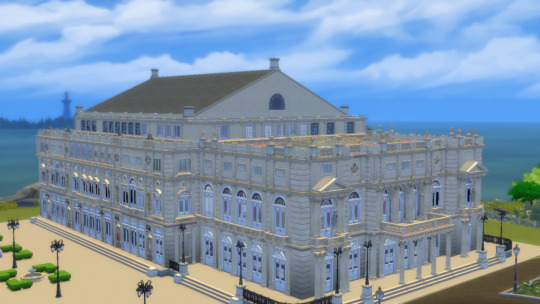



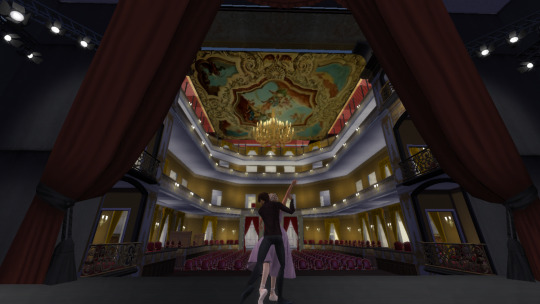
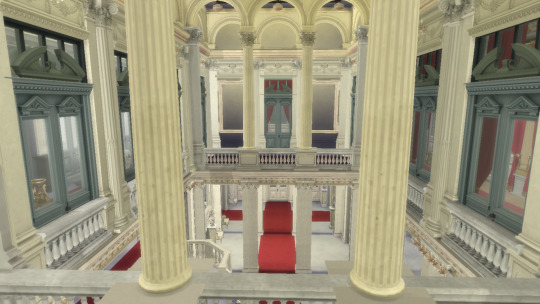
Colon Theatre
The Teatro Colón in Buenos Aires is one of the most important opera houses in the world. Its rich and prestigious history, as well as its exceptional acoustic and architectural conditions, place it on par with theaters such as La Scala in Milan, the Paris Opera, the Vienna State Opera, Covent Garden in London, and the Metropolitan Opera in New York.
In its first location, the Teatro Colón operated from 1857 to 1888 when it was closed for the construction of a new venue. The new theater was inaugurated on May 25, 1908, with a performance of Aida. Initially, the Colón hired foreign companies for its seasons, but starting in 1925, it had its own resident companies - Orchestra, Ballet, and Choir - as well as production workshops. This allowed the theater, by the 1930s, to organize its own seasons funded by the city's budget. Since then, the Teatro Colón has been defined as a seasonal theater or "stagione," capable of fully producing an entire production thanks to the professionalism of its specialized technical staff.
Throughout its history, no significant artist of the 20th century has failed to set foot on its stage. It is enough to mention singers such as Enrico Caruso, Claudia Muzio, Maria Callas, Régine Crespin, Birgit Nilsson, Plácido Domingo, Luciano Pavarotti, and dancers like Vaslav Nijinsky, Margot Fonteyn, Maia Plisetskaya, Rudolf Nureyev, and Mikhail Baryshnikov. Esteemed conductors such as Arturo Toscanini, Herbert von Karajan, Héctor Panizza, and Ferdinand Leitner, among many others, have also graced the theater. It is also common for composers, following the tradition initiated by Richard Strauss, Camille Saint-Saëns, Pietro Mascagni, and Ottorino Respighi, to come to the Teatro Colón to conduct or supervise the premieres of their own works.
Several top-notch maestros have worked consistently here, achieving high artistic goals. They include Erich Kleiber, Fritz Busch, stage directors like Margarita Wallmann or Ernst Poettgen, dance masters like Bronislava Nijinska or Tamara Grigorieva, and choral directors like Romano Gandolfi or Tullio Boni. Not to mention the numerous instrumental soloists, symphony orchestras, and chamber ensembles that have offered unforgettable performances on this stage throughout over a hundred years of sustained activity.
Finally, since 2010, the Teatro Colón has been showcased in a restored building, resplendent in all its original splendor, providing a distinguished setting for its presentations. For all these reasons, the Teatro Colón is a source of pride for Argentine culture and a center of reference for opera, dance, and classical music worldwide.
__________________________________________________________
You will need a 64x64 lot and the usual CC from TheJim, Felixandre, Harrie, Sverinka, SYB, Aggressivekittty, and other marvelous creators!
DOWNLOAD TRAY: https://www.patreon.com/user?u=75230453
(free to play 7/17)

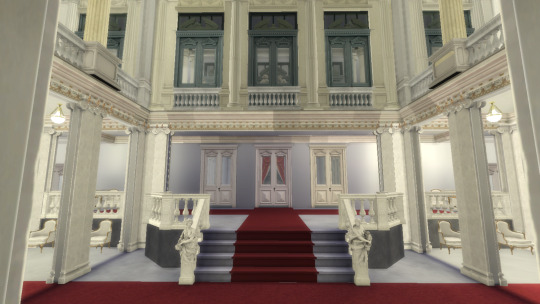
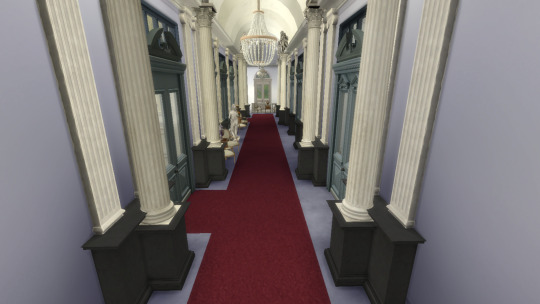
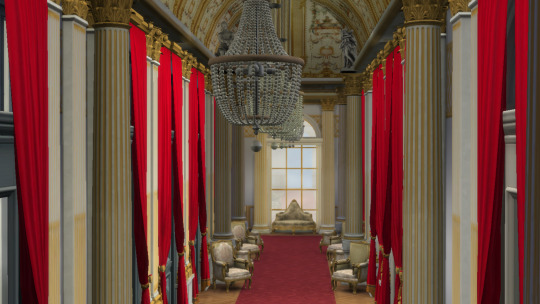


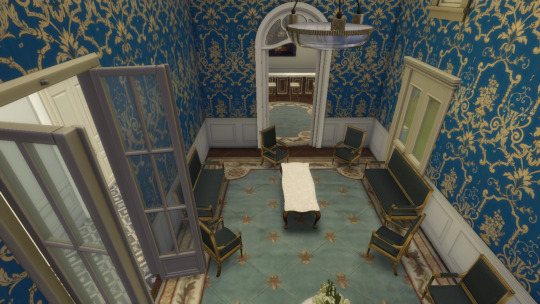
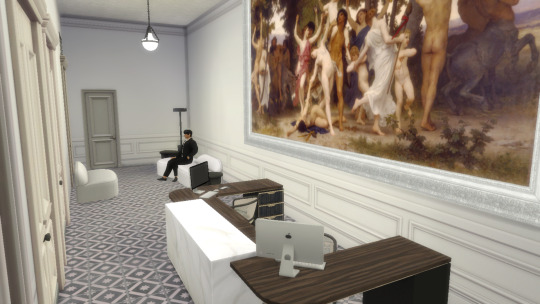




#sims 4 architecture#sims 4 build#sims4palace#sims 4 screenshots#sims4#sims4play#sims 4 historical#sims4building#sims 4 royalty#sims4frencharchitecture
71 notes
·
View notes
Text
#MixOfDay #Podcast #Radioshow #LiveDjset
Roy Thode recorded live at Studio 54 NYC November 5, 1981
This presentation from DJ Roy Thode was recorded live at Studio 54 on Nov.5, 1981. My release of this recording is, almost to the day, 42 years after the night it was recorded. I hope you enjoy this step back in time from Roy's opening records to his 'walking out the door' music at the end of the night as you relive "A Night At Studio 54". Keep On Dancing!!
studio54, r&b, hi-nrg, "classic disco", "house music", "retro dance music", "new york dance culture history", "marsha stern", "heartbeat of the dance floor", "roy thode", "classic dance music", "new york nightlife"
www.priokskfm.online
https://ift.tt/xnuHPRy
#classic disco#house music#retro dance music#new york dance culture history#marsha stern#heartbeat of the dance floor#roy thode#classic dance music#new york nightlife#Priokskfm#mixofaday#studio54#r&b#hi-nrg#The Heartbeat Of The Dance Floor ®#SoundCloud
1 note
·
View note
Text
The Lost Boys Former Lives - Dwayne❤️

Others: David, Marko, Paul
TW: Poverty, Emotional Abuse (not towards Dwayne), Workaholic tendencies, Depression, Gun violence/Gunshot wound, Death
The mysterious one of our Lost Boys and the third of Max's "family".
This is what Dwayne's life was when he was human.....

Dwayne was born in 1914 on a Wyandot reservation. Even before he was born there was quite an interesting family history. His father was a first-generation American citizen, as he was the son of Puerto Rican Immigrants. While still young and adventurous, he traveled the country, eventually finding his way to Oklahoma. During a camping trip, he met a lovely woman who was a part of the local Wyandot tribe. Smitten with her, he decided to stick around longer than originally planned so they could get to know each other better.
The two of them were inseparable, sharing details about their culture and language while also having fun exploring together. They fell in love, and thankfully, her mother, a highly respected councilwoman, allowed them to be in a relationship. While he stayed to help out with the community, he also started a family with the woman he loved.
Their firstborn was Dwayne, making him their eldest child. Dwayne had three younger siblings; two sisters and a brother. The earliest memories Dwayne had in his human era were of a blissful life with his family on the reservation. One of his favorite things to do was go scavenging with the other kids, trying to find treasures or pretty objects from the woods.
Unfortunately, the happiness was spoiled one day when local authorities passed through the area. Word had gotten out that Dwayne’s parents were married, and being an interracial couple, it was illegal in that time period. Very serious threats were made, and it scared them all. Out of fear for the safety of the community and their family, Dwayne’s parents decided to pack up and move with their children. Dwayne was only 6 at the time, and he never saw his grandmother or the rest of the tribe ever again.
It was a brutal travel period. His siblings were so young and so scared about where they were going, and Dwayne himself found it hard to be brave when things seemed so unsure. His parents were optimistic for the sake of their babies. After months of traveling across the country, they finally made it to his father’s original home in New York.
Dwayne’s father had plenty of family members living in Brooklyn, as more were immigrating to America to start new lives. While his father assured him they were somewhere safe, Dwayne felt very shy and reserved in the city. Unlike back in Oklahoma, he didn’t know anyone there and the city was far more crowded and noisy. He was incredibly scared, as were his younger siblings.
Due to financial strain, they had to move into an apartment with Dwayne’s grandfather. While it was a rough start, his parents were optimistic, doing what they could to make their children feel safe and comfortable. Having a very kind grandfather certainly helped. He often told Dwayne stories of the beautiful beaches back home in Puerto Rico. How warm the sun was and how friends and family would dance and party together while the waves moved across the sand. Dwayne had never seen the ocean before, but his grandfather’s stories were an inspiration for him to do so one day.
Living next door to them was Dwayne’s extended family. While his parents went to look for work every day, his aunt would help take care of him and his siblings. She had been a teacher before moving, so he learned a lot from her. He got along well with her and all his cousins, but he never found his uncle to be very friendly. Since he always seemed to be in a bad mood, Dwayne and the other kids found it best to stay out of his way.
When Dwayne got a little older, he went to look for small jobs to help out his family as well. His parents were both factory workers, so they were quite exhausted most of the time. The stock market crash of 1929 certainly didn’t help their situation, but Dwayne was willing to take on any challenge necessary. He wanted to do whatever he could to help lift the burden, especially if it meant keeping his baby brother and sisters fed. From shoe-shining to newspaper delivering to ditch-digging, he took on anything.
One thing he did in his free time to keep up his spirits was learn how to make his own jewelry. He had picked up some tips from his grandmother back in Oklahoma, so throughout the day, he’d collect trinkets to make into bracelets and necklaces for his siblings and cousins. It was a great way for all of them to bond together. His parents were proud of his hard work, praising his kindness and love for his family.
Times were already tough, but when Dwayne was 16, they got much worse. One night during family dinner, Dwayne’s father suffered a stroke as a result of the stress he had built up from work. Despite his and his mother’s efforts, his father died, leaving the family without their beloved patriarch. Dwayne held a lot of guilt, not being able to save his dad and feeling as if he didn’t help contribute enough to supporting his family so his parents wouldn’t have so much pressure.
From then on, Dwayne had to take on his role as the new “man of the house”. His mother didn’t want him to face the pressure of looking for more work, but after losing her husband, she had slipped into a deep depression, struggling to leave the apartment. Dwayne was insistent, promising to provide for everyone so she could stay and care for herself while his aunt and grandfather helped with the younger kids.
Dwayne jumped around from job to job, finding it hard to get hired for long-term work. However, he didn’t let it keep him down. He found that being serious and strong was the best tool for getting people to hire him. Whether it was factories or construction, he made it clear he was determined to work, and it got him what he wanted. Even if he was exhausted, he wasn’t going to let his father’s death be in vain.
Eventually, Dwanye found a stable job as a mechanic at a motorcycle shop when he was 18. He found that he was quite comfortable with putting parts together and finding problems with the vehicles. He became the go-to guy, building a good reputation with regulars. People saw him as a good kid with admirable work morale. It made his family happy to see him actually enthusiastic to go to work rather than be exhausted.
Dwayne had built up a steady flow of income, saving every little penny for his younger brother and sisters. He had dreams of setting them up in college someday and wasn’t going to rest until he did so. His grandfather would occasionally slip some extra bills into the stash to help rack up the total faster. He did a lot of little things for his grandson. Patching up clothes, making his favorite meals, and having some coffee ready for the two of them to drink and chat over.
But while things seemed to be looking up, another problem arose. One day after getting home from work early, Dwayne walked in on a fight between his aunt and uncle. She had caught him trying to take the money he had saved up for his siblings, and he had gotten aggressive with her as a result.
As it turned out, he had been stealing from both Dwayne’s father and grandfather. When his father died, his uncle started looking for his savings to make up for the financial loss. The worst part was that he was only interested in using the money for himself, not his children. He apparently hadn’t even wanted them in the first place and was bitter about having them in his life.
Fed up with his loved ones facing hardship and stress, Dwayne took action. Now a strong, young man, he was able to force the man out of their apartment building, dragging him into the street and threatening to do something terrible if he didn’t leave and never come back. He refused to let his cousins be poisoned by a leech of a father and see the rest of his family be taken advantage of. He would do anything to make sure nobody hurt them ever again.
Overwhelmed with the stress and pressure of protecting his loved ones, Dwayne decided he needed a hobby. Something to take his mind off of his problems. After doing some thinking, he ultimately decided to make his work his hobby, putting in the time to actually ride a motorcycle. He picked out his own special ride and tweaked it to his liking, making it all his own to enjoy for rides. The fresh air and speed of the bike helped take the pressure off of everything in his life.
Though he found his distraction, Dwayne still carried quite a bit of exhaustion. During a drive on his motorcycle, he started to nod off while driving, causing him to veer off the road and fall into a ditch. Thankfully, two blond boys came to his rescue.
His injuries were patched up by David and Marko. They explained they met in Italy and had come back to America after traveling throughout Europe for a few years. Their caretaker, Max, still had his fortune and was attempting to find opportunities to build up the economy in New York City. Dwayne was perplexed by the boys. They spoke as if they were old men with a lifetime of experience, yet they were both so young.
Dwayne wanted to jump right back into work, but the two boys could tell he was quite burned out. Thanks to their charisma, they managed to convince him to have some fun with them. They went out to a few different jazz clubs in the city, and Dwayne had an amazing time dancing with them both.
From then on, every night after helping get his siblings and cousins to bed, Dwayne would go out and have fun with David and Marko. He felt such a strong connection with them, never wanting the fun to end. They made an offer of such when they told him they were planning to travel through Canada and a few other states next. The idea of exploring more of the world reminded Dwayne of his father, who he still missed so much.
He was so torn. They were such amazing friends and offered him a life with no worries or cares, but he felt like he had a responsibility to his family. Dwayne wasn't entirely certain what to do…until the night he learned vampires were real.
David and Marko had walked him home when he noticed his uncle was back and shouting on the street. He was threatening to get violent with his estranged wife if she didn't give him some money. Without thinking, Dwayne jumped into action, wanting to protect his family. He and his uncle got into a fight, and the latter pulled a handgun out, shooting Dwayne in the stomach in the scuffle.
He ran away, leaving Dwayne to bleed to death in the street. Marko and David stayed with him, promising not leave.
To Dwayne's surprise, his friends offered to help make the problem go away. When he said yes, they revealed their vampire faces.
Though he was frightened and confused and quickly losing blood, David soothed his mind with sweet promises of an eternal life of fun. That he could be turned and make his first kill right then and there, and his family would never be harassed again. He would be powerful, never tired or sick. All would be well.
Dwayne didn't even hesitate with his answer. He drank from the bottle David always carried in his coat, allowing the mysterious substance to heal his gunshot wound and change his body into that of an immortal being. He didn't know what he was getting into, but he trusted his new friends. He would do anything for them, and he has unfinished business with the monster that threaten his family.
With the help of the others, Dwayne hunted down where his uncle was hiding, and went in for the kill. Now half-vampire, he dragged his uncle into a darkened alley to finish him off. He snapped his neck and drank deeply. When his work was done, Dwayne tossed the body into a landfill. The job was done, and his friends were thrilled.
However, the success came with a cost. He was now a vampire, and that meant he had to be with his own kind.
He knew he had to say goodbye to his family, and it was the hardest thing he had to do. Only his grandfather was still awake at that hour, and Dwayne came to him with a heavy heart and the money he had saved up, asking him to give it all to his mother and younger siblings. His grandfather was sympathetic, telling Dwayne how much he was like his father, and he also deserved to enjoy life and be with new friends while he was still young. He thanked his grandson for taking such good care of them all.
When he was ready, Dwayne headed out with David and Marko. In his eyes, they were his family now, and he was always going to be there for them. He vowed to protect them and anyone else who would join their pack. David affectionately nicknamed him their "knight".
It would be the start of a carefree life for Dwayne. No more hardship or pain. Just fun for the rest of eternity with his beloved friends.
Additional Facts:
Dwayne was 23 when he turned. Physically, he is the oldest out of the four boys, but David is still technically the oldest since he's been alive the longest.
He and Marko are the only ones in the pack that speak multiple languages (Dwayne speaks Wyandot, English, and Spanish)
The two fangs he wears as an earring and part of his necklace used to belong to his parents. They each had one to symbolize how they were stronger together. Now Dwayne carries their strength with him.
When he lived on the reservation, their home was a longhouse. Moving into a cramped apartment was a difficult change for Dwayne. When he eventually got to see the cave, he loved it because he had gotten back the space and privacy he missed for so long.
While still getting to know them, Dwayne took Marko and David on rides on his motorcycle. They loved the rush it brought them, so he got them set up with their own rides (thanks to Max’s money). Because of his experience as a mechanic, Dwayne is the one who makes alterations and repairs on all their bikes.
He’s also the one that made all their earrings. He values his friends quite a lot and passing on his love for making jewelry as a way to symbolize their bond is something truly special.
After getting his first leather jacket, he thought it was missing something. Marko offered to use his skills and paint something on it. Dwayne picked a leopard because his grandfather’s nickname for him was “Gatito” (little cat)
When his father died and he had to look for more work, Dwayne reluctantly cut his hair so he would be taken more seriously. It broke his heart to do so, as long hair was a part of his and his mother’s identity. When he became a vampire, he vowed to never cut it short again.
Dwayne is incredibly fatherly from his experience caring for all his siblings and cousins. Though he’s more relaxed now, he still looks after his packmates like a big brother would. Whether that’s fixing something of theirs that’s broken or making sure they have someone to talk to, he’s there for them.
He hates cold weather and winter is his least favorite season. It brings hardship and struggle, not to mention he has seasonal depression. He gets super gloomy during the winter months, as there are so few people out and less fun stuff to do.
Dwayne cried tears of joy when he saw the ocean for the first time. He quickly learned how to surf and would spend as much time in the water as possible whenever he got the chance. Even though his human memories are gone, he still felt the warmth from his grandfather’s stories of Puerto Rico.
The others all secretly think Dwayne is the most attractive of their group. They never hide their affection for him and build up his confidence by telling him how handsome and alluring he is. He can still be quite shy, but when he’s feeling confident, he’ll woo them with sweet words in either Spanish or Wyandot.
Speaking of which, he has special pet names he uses in said languages. His favorite ones in Wyandot are SkahIwaha (Pretty Flower) and Agwahitsa (Doll), while his favorite ones in Spanish are Mi Vida (My Life) and Cariño (Honey/Sweetie)
When skateboarding became a thing in the late 40s and early 50s, he was eager to learn how to ride. He found that the movements were similar to surfing, and became quite the natural. The others love watching him perform tricks whenever he got the chance to do so.
He believes that his love of moving around comes from muscle memory of his human life when he was constantly busy with work. He truly does love to relax and slow down in order to enjoy life, but his body just still has the itch to keep active. The others are just grateful he’s doing it in a way to have fun, and not turning to back-breaking labor.
Unlike Marko and David who started a more intimate relationship quite fast, Dwayne took his time building up the romance with his pack mates. He loves taking them on dates and giving them presents while spending quality time with each of them. It doesn’t hurt that he’s also a very giving lover.
Dwayne firmly believes in the idea of soul mates. He thought his parents were soul mates because of how much they loved one another, and now he believes that the boys are his soul mates.
Dwayne is the muscle of the pack. He’s not looking for fights constantly, he’s just intimidating enough to make sure nobody hurts them, especially not David.
He adores Laddie because the boy is exactly like the little brother he had in his human life. Dwayne wanted children one day but never got the chance. He feels the need to care for Laddie and take him under his wing. Sometimes he’ll even call him hijo (son), because that’s what his father called him.
Dwayne loves rock and roll just like the others, but he also has an impressive collection of jazz records. Even if he doesn’t remember it, the music makes him feel the same happiness he experienced hearing it in New York.
(Dwayne being half-Latino comes from the novelization. Michael describes him as “Latin-looking”. Being half-Native comes from Billy Wirth’s own identity)
He prefers warm beverages over cold ones. His drink of choice is a cup of plain, black coffee
Dwayne is an amazing dancer, as he learned quite a bit from both cultures he grew up in. He can be a little timid about dancing, especially in front of others, but when he’s feeling brave, he’ll dance with a partner. His favorite style is bachata.
203 notes
·
View notes
Text
MOGAI BHM- Day 13!
happy BHM! today i’m going to be talking about ballroom culture!

[Image ID: A black-and-white photograph of a drag ball. In the photo, a crowd of Black people are standing around a gated area in a room, watching a Black man, dressed in a short black dress and black combat boots, dance and pose on the tiled floor. End ID.]
The history of drag ball culture can be traced to the 1920s in New York City, just before queer culture began to rise in Harlem and the Harlem Renaissance- however, at this time, mainstream drag balls were pretty much all white. Black performers were allowed to participate, but they were asked to lighten their skin in order to do so, and were often judged harshly and unfairly by completely white judge panels.
This horrible racist abuse led Black and other non-white queer people, especially indigenous and Latino queers, to form their own drag ball subculture. They would organize their own balls, sometimes in official drag ballrooms, and sometimes in their own homes, and drag ball culture really grew during the 60s, 70s, and 80s.
During this time, drag ball culture was organized into different “Houses”, which were official establishments of the culture and events, but also frequently served as solace and shelter for Black and Latino LGBTQ people who had been kicked out of their homes or were facing violence for their identities. These Houses were based on the concept of family and love and defiance, and were the soul of drag ball culture. The first house, which kickstarted ballroom culture from the 1960s on, was the LaBeija House, founded by Crystal and Lottie LaBeija in the 1960s as a response to the racism they’d experienced in extant drag scenes in New York City.
There were many, many, many Houses that participated in drag ball culture- some of the most famous ones include The House Of Ebony, The House Of Xtravaganza, and the House of Ninja. All houses were led by “mothers” and “fathers”, usually elder members from drag ball culture.
Drag scenes in this time period consisted of several different opportunities, mainly for lesbians, both cis and trans, gay men, and trans women. Contestants would “walk” (perform) and participate in different categories based on their identity or how they expressed themselves. These categories produced a lot of queer language as we know it today.
Two terms that originated with/were popularized by ballroom culture of the late 1900s, were ‘butch queen’ and ‘femme queen’. ‘Butch queen’ was a category for performers who were gay men but did not possess hyperfeminine or hypermasculine qualities/expressions, but rather a combination. The term was for a uniquely queer celebration of a blending of masculinity and femininity. ‘Femme queen’ was a category for people who would today be considered transgender women- people who were born ‘male’ but sought forms of gender, sexual, and/or social transition to live and present as a woman.
Femme queens and butch queens were the biggest parts of drag culture. They accompanied other categories, like for butches (not butch queens) who were masculine lesbians. Other categories highlighted ‘Realness’ (the ability of performers to ‘pass’ as straight men/women), ‘business executive’, and several categories that allowed men to still be masculine and women to still be feminine.
Language was very important in drag ball culture. ‘Femme’, ‘butch’, ‘queen’, they all described an aspect of queerness that was personal and yet political at the same time. This dedication to queer language led to the development of unique terms and language to define aspects of ballroom culture- in fact, most modern ‘queer’ language has been appropriated by white queer people from ballroom culture. Terms like ‘spilling tea’, ‘work’, ‘slay’, ‘yass queen’, and many others, all originate from ballroom culture. Many popular dance trends and moves, including the infamous ‘voguing’, also originate from the dance aspects of ballroom culture.
Although the history of drag kings is very often overlooked, they were and just as integral to drag culture as drag queens are. There were drag ball categories for trans men, butch trans men, and for trans men to ‘pass’ as gay men. Butch and trans men categories and experiences in this culture were emphasized and related, building the shared history between butch lesbian and trans male communities. queer history is inextricable from this kind of Black and Latino history. Queer language is not just queer language, and its history deserves to be known and respected.
Sources-
https://mozartcultures.com/en/understanding-the-ballroom-culture-its-incredible-impact-on-the-world/
https://www.allgaylong.com/blog/a-brief-history-of-modern-ballroom-culture/
https://en.wikipedia.org/wiki/House_of_LaBeija
https://time.com/5941822/ballroom-voguing-queer-black-culture-renaissance/
@metalheadsforblacklivesmatter @intersexfairy @cistematicchaos
136 notes
·
View notes
Text
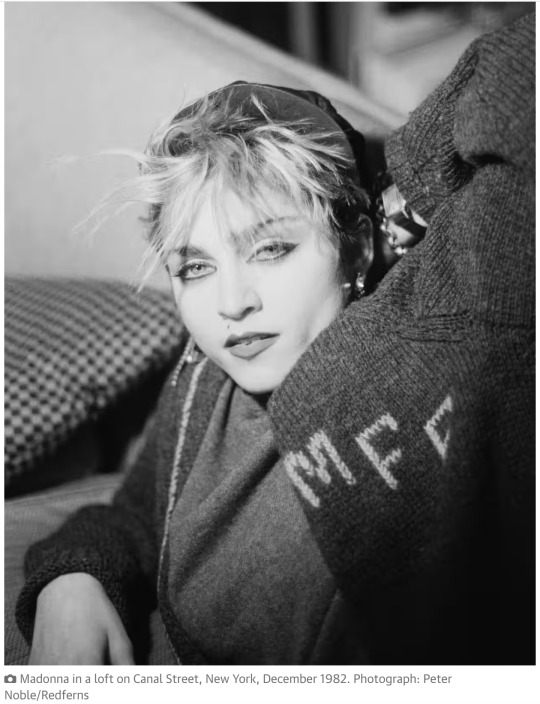
Thurston Moore on Madonna: ‘She had credibility, she was really ahead of the game’
The former Sonic Youth frontman remembers her emergence from New York’s underground scene.
We were neighbours. We knew each other, by sight. She would say hi to me and I would say hi to her. She was dating a friend of mine for a millisecond, so we were introduced that way and then, through the years, when we’d cross paths on the street, we’d nod heads and smile. She was very friendly with Jean-Michel [Basquiat], Keith Haring, and these artists who were all our neighbours, and we all hung out at the same places: Danceteria, CBGB, Tier 3 and Club 57 were the main places. When she became super-famous, which was all of a sudden, she disappeared from the New York scene. It was a very strange thing, to be working washing dishes, and making pennies per day, and seeing someone who was in your neighbourhood all of a sudden become a superstar. It was unusual. There was no real model for that, for us. It became kind of exciting.
She was really ahead of the game. She was taking elements of what was cool at that time – punk rock, new wave, dance music, hip-hop and Latino music all clashing in this great non-hierarchical playground of New York. It was all kind of new; everybody was trying different things. Madonna was actually in a couple of no-wave bands that nobody ever talks about. She was in a band with these two twins, Dan and Josh Braun, who were the first members of Swans, Michael Gira’s band. Nobody really knows about that part of her history; she was in a pre-Swans no wave band! There’s all that interconnected history in New York with Madonna and the no wave scene.
She was really able to tap into the sound of what was genuine and the culture at the time, where it was free from any gender or sexual persuasion distinctions. There was no concern about any inequality or [the boundaries of] gender or race – that’s how we felt, it was totally revolutionary. And [there was] this balance between Latino, black and white culture on the scene. She was really significant in giving voice to that and consistently doing it – you never got the sense that she was doing it as a gesture of being hip. She was a person, I think, who was really very loving toward people who were historically disenfranchised by society.
We actually embraced Madonna’s joie de vivre, her celebrity. We did that record and everybody felt we were crazy, and some people lambasted us for giving her some kind of credibility in the underground. But she already had credibility, as far as I was concerned; she was already a part of the downtown scene. I don’t think she capitalised on it.
When we first came to London, Lee [Ranaldo], Kim [Gordon] and I wore Madonna shirts and I remember kids at the gig coming up to us and saying “Are you taking the piss?” and we would say “No, have you heard this Madonna album? You should listen to it next to your Swell Maps albums, next to your Wire albums, next to your Raincoats albums.” Mix it up. Don’t be stuck in some kind of tunnel. I was all about bringing people together. Plus the T-shirts were really cheap.
Actually, I think she was very dignified in the way she referenced all of these different subcultures. She was a very big part of it. She made a lot of money, and when you make a lot of money and become so famous you have to protect yourself, because everybody wants to claw at you. It’s not like she could just walk into a Tesco and buy milk; she’s going to get hammered. People who bring that in to their lives… it’s a mixed blessing. It does prohibit you from being free in the social world. I think she dealt with it really well, let’s put it that way.
#Madonna#Thurston Moore#Sonic Youth#early Madonna#no wave#Kim Gordon#Lee Ranaldo#Danceteria#CBGB's#NYC#Lower east side#Queen of Pop#Peter Noble
20 notes
·
View notes
Note
JUSt needed to tell you that thinking about "Profile in Quicksilver" got me through the day 💕💕💕
I also love how you incorporate worldbuilding details seamlessly into the narrative without being overwhelming! I love reading Gale & Draxum talking! Do u have any religion/traditions/custom headcanons that didn't show up in the fic (yet)?
thank you so much for writing!!!
Thank you! I do try to avoid lore dumps, even if they can be interesting at times. Ideally, people won't realize they're being lore dumped on. It's like, in a dance when you transition to a different blocking, ideally the audience shouldn't even notice you're transitioning, it should just feel like part of the choreography.
And OH FUCKING BOY DO I. Thinking about the background of the Hidden City and the Yokai as a whole has been so much fun. Making it fit with the lore we see in the show and the actual history of New York City has been so much fun-like, it's not that there happens to be a giant monster city under NYC, NYC became NYC because there was a giant monster city already there. And that's why NYC is Like That. Why are all the dark armor pieces in New York? Because that's where most magic is now, magical beings were driven out from everywhere else.
As far as religion, I've been keeping them pretty secular? Mostly because that's just an aspect I don't feel really jives with TMNT. I have a scene later on where Leo and Mikey attend church with April and her parents, but it's more out of curiosity than any real desire to take up religion. They see it as more of a cool cultural thing that an actual system of beliefs. One of the main things I can remember right now is Leo bitching about the smell of incense.
In the background, I think of the Yokai as following a lot of pagan religions. These people haven't been directly colonized or conquered (or more accurately, were ethnically cleansed instead of being colonized or conquered) so Christianity and Islam are much less common. Probably the same with some other religions that spread due to conquest, but I'm not...entirely sure what those religions would be. (Hellenism? Zoroastrianism? Taoism? Do those fit? I'm singling out Abrahamic religions because those are the most common currently) Also Christianity and Islam are pretty young religions. I haven't made a definite timeline, but I'm leaning towards most Yokai communities being established more than 2000 years ago. Leo mentioned in the Christmas chapter that there were a lot of bright reds and lights down in the Hidden City-pretty much everyone has a winter solstice holiday, so officially they're celebrating the solstice instead of any one religious holiday, and everyone's kind of free to celebrate however they want. Not a lot goes down in December, actually. Schools have most of the month off, a lot of workplaces cut their hours or just straight shut up for a few weeks, most people are partying and spending time with family. It's basically like their summer vacation.
Oh! One thing I will probably work in at some point, but the last of the Yokai migrations happened during WW1. The few remaining exclaves in the human world (like the one in Chongqing, where Tigerclaw was living) basically went "fuck it" and packed up shop, even in places where there was no fighting. It was the nail that drove home that they couldn't exist alongside humans, that even if they weren't warring with the humans themselves they would still get roped into human conflicts, and eventually they would be killed off.
And the thing is, up until recently, the Hidden City was still rather closed off from the human world, despite living underneath NYC. You have to get government approval to go topside, so most people were living their entire lives underground without ever stepping foot in NYC proper. It was really with the invention of television and then the internet that bridged the gap from the Yokai's side, and both those things took a lot longer for the Yokai to adopt. So a lot of human stuff that happened from the 1910s to around 1970s-1980s era didn't get a lot of attention down there.
Like. They know WWII happened. Objectively. By that I mean they knew shit was going down, so the Heads pulled down just about everyone who worked up top and they all just bunkered down for several years until they realized the war was over. It was an annoyance for most of them, a period of time where they couldn't get certain products or had their business disrupted because somewhere in their chain was a guy who worked at a human company and he can't do that now. They were able to read about what happened afterwards and knew vaguely of all the genocides, but most of them didn't look into it very hard. Just more humans bent on killing each other, what else was new? Most of them will still refer to WW1 as 'The Great War.'
And I thought of this scene before October, and I feel like I probably shouldn't use it now due to how politically charged it is, but originally I wanted to include a scene where someone mentions Israel and Josh is really confused because the last time he was living aboveground that area was controlled by the Ottomans and was officially part of Syria. Maybe independent Jerusalem, but why would it be Israel? Bella has to pull him aside and explain. He knew about the Holocaust, but he had no knowledge of Mandatory Palestine or the Nakba. The entire time she's talking and his eyes are just bugging out.
On the plus side, India is no longer under British rule, so he was probably pretty happy to find that out?
I had like several other things I rambled about and deleted because they were going entirely off the rails, I might post those at another time. I've thought about this world way too much and I've written far too little down. (also sorry it took so long to respond! I knew I'd go crazy and wanted to get the chapter done first, and the chapter took longer than I expected lol)
#doth asks#i both love and hate info-dumping worldbuilding stuff like i feel like i'm just total stream of consciousness sometimes
16 notes
·
View notes
Text
some newsies film & broadway musical theories that i've read (disclaimer, these are not my original theories):
jack's biological dad can be linked to alfred borden's character in "the prestige." this connection is evident in their physical resemblance & shared predisposition for legal troubles. borden's history includes visits to new york & numerous romantic liaisons.
jack's evolution into a vigilante reminiscent of the iconic batman takes shape in a unique narrative. his backstory is shrouded in tragedy, with the absence of his parents casting a long shadow over his life. perhaps their untimely demise occurred in a dark alley, thrusting jack into a life of orphanhood. alternatively, his journey might follow a path where he embarks on a quest to acquire the skills necessary for combating crime in the gritty underworld of 1920s gotham (which is also an old nickname for new york city). these acquired abilities encompass the realms of stealth, martial arts, & even the art of synchronized dance—a mysterious & unconventional arsenal he aims to employ in his quest for justice.
the outcome of "independence day" can be likened to a whimsical twist of fate. in a humorous interpretation, it could be suggested that an extraterrestrial species watched "newsies" & concluded that the incumbent president would respond to their threat with dance, anticipating an easy conquest. however, their expectations were wildly off the mark. instead of encountering a docile figure, they were met with a resolute leader in bill pullman. this unforeseen turn of events resulted in a level of resistance far beyond what the alien race had anticipated.
the delancey brothers' backstory indicates a history of childhood abuse & neglect. oscar's disclosure in the musical reveals that their father failed to provide proper care for them. additionally, their living arrangement with wiesel, who is referred to as their uncle in the film, adds a layer of complexity to their upbringing. oscar & morris exhibit signs of excessive aggression & violence, extending beyond the demands of their occupation. morris, in particular, displays a proclivity for resorting to intimidation whenever possible. these behaviors are often characteristic of individuals who have survived childhood abuse without addressing the underlying trauma. these experiences may also elucidate the pervasive anger exhibited by these characters, despite their youthful age, as violence can frequently be a learned response in such cases.
david & les have not been explicitly identified as jewish in the final version of the movie or the musical. however, an original script for the film suggests this aspect of their background. there are subtle clues in the narrative that allude to their potential jewish heritage. for instance, the name david jacobs implies a connection to jewish culture, & david's articulate & scholarly manner of speaking aligns with the jewish tradition's emphasis on education. the reason david & les do not openly discuss their heritage in the story could be attributed to various factors. one possibility is that their parents have a long history in america, spanning several decades or more. alternatively, they may be recent immigrants who have faced significant discrimination, prompting them to encourage their sons to assimilate fully into american society.
crutchy's previous stay at the refuge is a matter of record. he confided in jack that if anyone suspected he couldn't fend for himself, he'd be detained there indefinitely. it's possible that crutchy had a prior stint at the refuge, & if that were the case, jack might have played a role in securing his release. despite crutchy not fitting the typical profile of a criminal, his disability might have driven him to resort to theft as a means of survival. in the year 1899, opportunities for individuals with disabilities to secure employment were scarce or virtually non-existent. moreover, it's plausible that crutchy ended up at the refuge simply because of his disability, as the prevailing belief may have been that he had limited prospects for adoption, academic success, or societal contribution according to the standards set by able-bodied individuals.
jack's father shared tales of santa fe with him. mr. kelly (sullivan) harbored aspirations of relocating his family to that enchanting place, where they could pursue a ranching life, well before the bustling streets of new york had worn him down. jack became captivated by this vision, & he might have even harbored intentions of upholding his father's dream as the head of the household, had the family endured.
#newsies#newsies 1992#1992sies#newsies film#newsies movie#newsies broadway#newsies musical#newsies 2017#newsies 2012#jack kelly#francis sullivan#delancey brothers#morris delancey#oscar delancey#crutchy#crutchie#davey jacobs#david jacobs#les jacobs#batman#independence day#alfred borden#the prestige#the refuge#santa fe#film theory#newsies notes#new york#gotham
26 notes
·
View notes